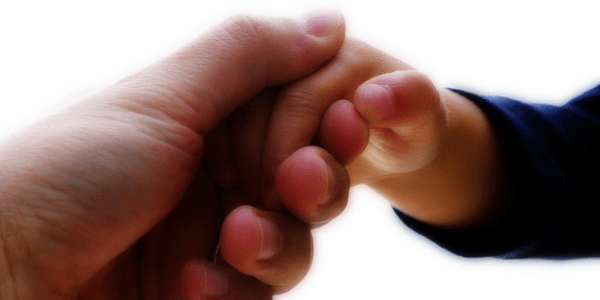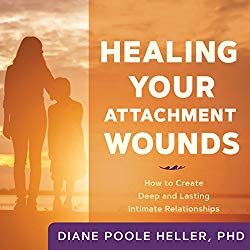Healing Your Attachment Wounds: How to Create Deep and Lasting Intimate Relationships, by Diane Poole Heller
Sounds True, Audio Book, 9781622038732, 9 tracks, 2017
We all have an attachment style, an unconscious psychological program that we use to form and maintain relationships with other human beings. It’s developed in infancy by the interactions we have with our parents or early caregivers, and it is the basis for every close relationship we’ll form throughout our lifetime. Diane Poole Heller, Ph.D., is an expert in adult attachment theory and models, trauma resolution and integrative healing techniques. In her new audio book Healing Your Attachment Wounds: How to Create Deep and Lasting Intimate Relationships, she explains what attachment is and how it forms, acquaints us with the four attachment styles, gives us some exercises to explore the styles, and finally, explains some ways we can modify our style (and ask for help from our loved ones) to enter into close, loving relationships.
The course is broken up into nine sections, each containing between five and nine subsections. In the first section, Heller explains that one’s attachment style gets recorded in implicit memory, arising from our experiences as infants — before we can consciously remember them. These behaviours and responses become automatic, “programmed” into us without our having to think about them, and they get triggered when we perceive our current experience mirroring an original experience. Thus, the formation of our attachment style is totally out of our control, which utterly relieved me and removed the shame and guilt around what I had perceived as personal failures in some of my relationships. Happily, Heller stresses throughout the course that we can learn a secure attachment style. She calls this “hitting the jackpot in the attachment style lottery.”
Heller speaks in a clear and vibrant (if somewhat fast) voice — it’s evident she’s excited to share her knowledge and experience with us. In some of the sections, after she speaks about an attachment style, she guides us through mini-meditations to explore our earliest memories or feelings that may give us clues to discovering our own style. She encourages us to continue working with the exercises over days or weeks to go deeper. She also provides examples of behaviours, sometimes using clients’ experiences, that illustrate how a person with a particular style will act and respond in a relationship. These are all quite helpful; by the end of the course, I was able to identify what I thought was my own attachment style. It’s no substitute for in-person therapy, but it’s a good beginning.
Four attachment styles are discussed: secure, avoidant, ambivalent, and disorganized. Secure is the healthiest, and it characterized by being able to give and receive expressions of intimacy, having well-developed boundaries, being comfortable alone as well as with others, having a positive view of relationships, and the willingness to discuss differences rather than attack or avoid. Avoidant is characterized by prizing independence, personal freedom and self-sufficiency, and tending to avoid emotional intimacy and commitment. Ambivalent is characterized by being fearful of relationships in case a partner leaves, yet desiring to be in a relationship, and needing constant reassurance that their partner is truly committed to them. Lastly, disorganized attachment style arises out of early childhood hyper vigilance, and seeking out physical contact, but then rejecting it.
Each of the nine sections is broken up into several subsections, ranging from about three to 15 minutes each. For review purposes, I had to listen to all of them in the space of a few hours, but if not pressed for time, you can easily take in just as much information as you can stand, and leave the rest for another day. I thought this was a smart arrangement due to the deep emotional nature of what you may uncover. As in regular therapy, time and patience are your friends.
Short meditations are scattered throughout the tracks; for example, the meditation provided for the secure attachment style asks you to go back over your life and find people who may or may not have been your caregivers that you felt or feel safe with. Feeling safe in a relationship is one of the cornerstones of a secure attachment, according to Dr. Heller. This meditation allows you to explore what safety feels like, so you may recognize it in a current or potential friend or partner. I did all the meditations, which helped me get acquainted with my own presumed attachment style.
Once you order it, the course is available on the Sounds True website in several ways: an M4B (audiobook file), an MP3 (audio file), a WAV file (high-res audio file), or a ZIP file of MP3s. The ZIP file is the quickest way to download, since there are so many parts. If for some reason, you can’t download the ZIP file, you will need to download the subsections one by one (about 50 in all), which takes a bit of time. You can also purchase it in as a CD from Amazon or download it for free as an audiobook through Audible.
If forming and keeping satisfying relationships has been a source of frustration, Healing Your Attachment Wounds is a solid first step to exploring why. Working with this course may allow you to recognize and modify your attachment style enough to begin to reverse that trend. It will surely give you enough information on what you think your style may be to discuss with a potential therapist if you want to seek personal treatment. Considering that intimate relationships are the most precious things we have in this world, it’s time well spent.
Image Credit: Johnathan Cohen










